Vestibilità e comfort del casco per i motociclisti
- La vestibilità e il comfort adeguati di un casco da motociclista sono essenziali per la sicurezza e l'esperienza di guida.
- Scegli il casco giusto in base alla forma della testa, alle dimensioni, allo stile, alle caratteristiche e alle classificazioni di sicurezza.
- Posizionare il casco in modo aderente e sicuro, assicurandosi che aderisca bene alla testa senza creare fastidio.
- Regolare il sistema di regolazione (se disponibile) e il cinturino sottogola per una vestibilità personalizzata.
- Ammorbidire il casco, aggiungere o rimuovere l'imbottitura se necessario e prendere in considerazione un sistema di comunicazione sul casco per un maggiore comfort.
- La manutenzione e la sostituzione regolari del casco sono essenziali per garantire sicurezza e comfort costanti.
Vestibilità e comfort del casco: una guida completa per i motociclisti
Mantenere una calzata corretta del casco e un comfort ottimale è fondamentale per la sicurezza e l'esperienza di guida dei motociclisti. Un casco mal calzante può compromettere la protezione, diminuire il comfort e portare a potenziali pericoli. Questa guida fornisce approfondimenti completi sulla selezione, la calzata e la regolazione di un casco da motociclista per la massima calzata, comfort e protezione. Esploreremo anche i modi per garantire il comfort del casco a lungo termine durante i tuoi viaggi in moto.
I. Introduzione
A. Importanza della vestibilità e del comfort del casco per i motociclisti:
I caschi da motociclista correttamente calzati sono essenziali per la sicurezza e il comfort dei motociclisti. Un casco ben aderente non solo aumenta la protezione in caso di incidente, ma riduce anche il rumore del vento, riduce l'affaticamento e ottimizza il comfort di guida generale.
B. Conseguenze di una calzata non corretta del casco:
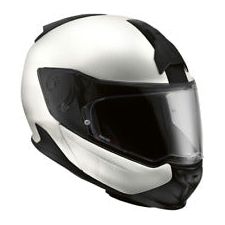
Titolo: CASCO BMW MOTORRAD SYSTEM 7
Prezzo: £520.00
ACQUISTA ORA
Compromettere la vestibilità del casco può avere gravi conseguenze. Un casco non adatto può:
- Offrono una protezione inadeguata in caso di incidente, aumentando il rischio di lesioni alla testa
- Causano disagio e affaticamento durante i viaggi lunghi, portando potenzialmente a distrazione e riduzione del piacere di guida
- Generare un rumore del vento eccessivo, compromettendo la comunicazione e la consapevolezza della situazione
II. Scegliere il casco giusto
A. Determinare la forma e le dimensioni della testa:
- Misura la circonferenza della testa:
Per determinare con precisione la taglia del tuo casco, misura la circonferenza della tua testa usando un metro a nastro flessibile. Posiziona il metro attorno alla tua fronte, leggermente sopra le sopracciglia, e avvolgilo attorno alla parte più larga della tua testa. Registra la misurazione in pollici o centimetri.
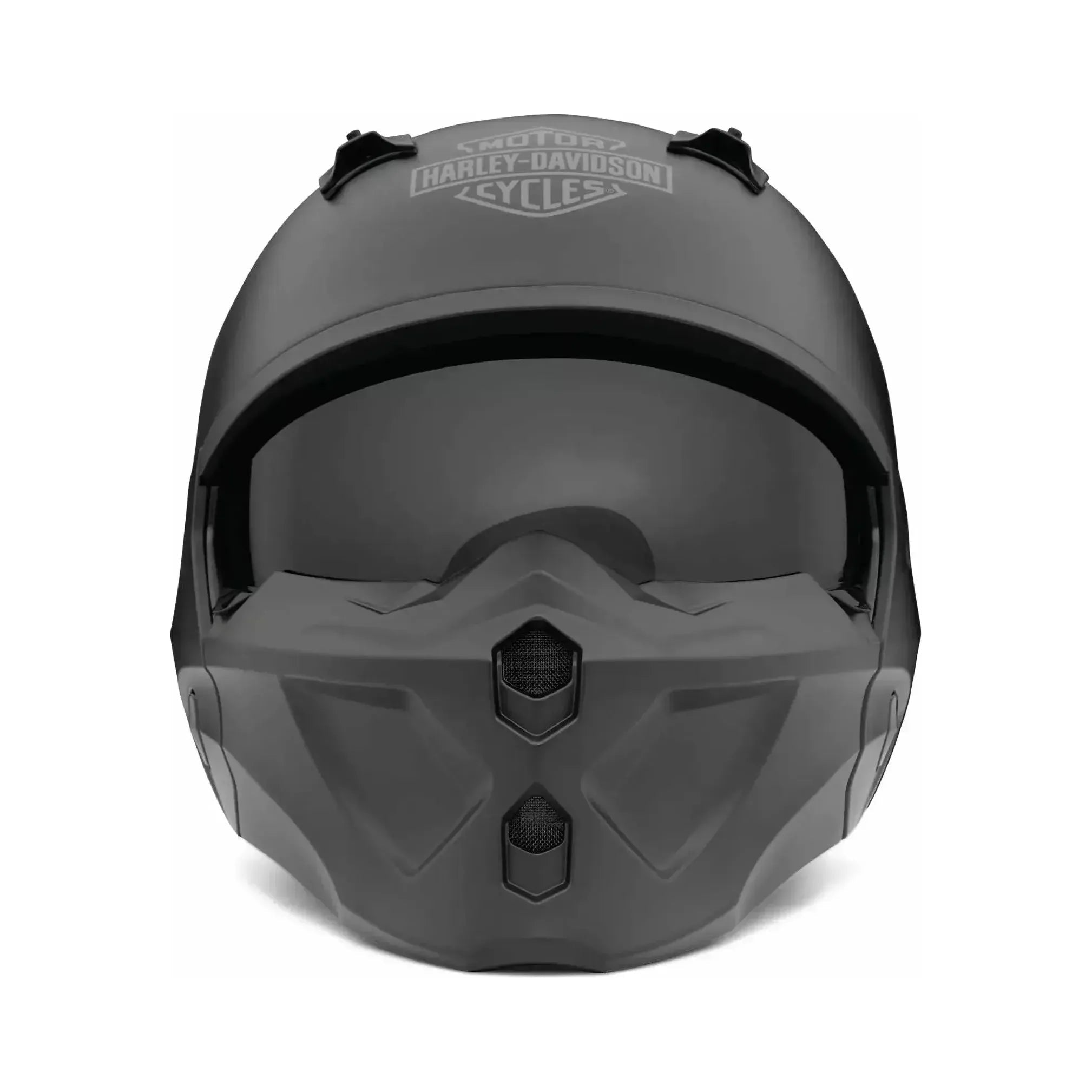
Titolo: CASCO 2-IN-1 HARLEY-DAVIDSON® GARGOYLE X07
Prezzo: £269.99
ACQUISTA ORA
- Considera la forma della testa (ovale, rotonda, intermedia):
Le forme della testa rientrano generalmente in tre categorie: ovale, rotonda e intermedia (combinazione di ovale e rotonda). Identificare la forma della testa aiuta a restringere la scelta del casco che offre una vestibilità comoda e sicura.
B. Seleziona lo stile del casco:
- Casco integrale:
Offre la massima protezione poiché copre l'intera testa, compresi viso e mento. Consigliato per tutti i tipi di guida, in particolare ad alta velocità e per viaggi su lunghe distanze.
- Casco Jet:
Offre una copertura inferiore rispetto ai caschi integrali, esponendo il viso. Adatto per la guida informale in aree urbane o a bassa velocità. Non consigliato per la guida in autostrada o su lunghe distanze.
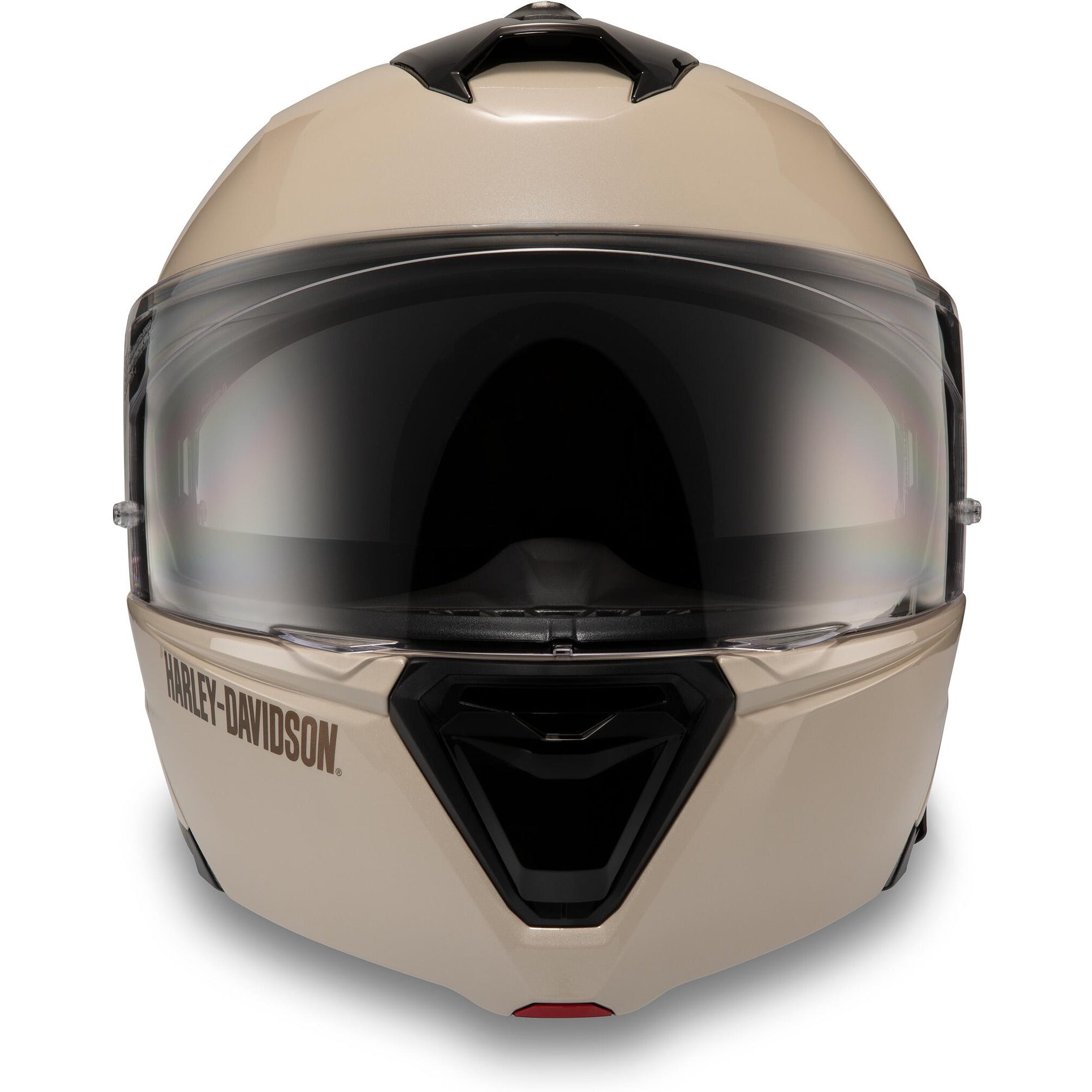
Titolo: CASCO MODULARE HARLEY-DAVIDSON® CAPSTONE SUN SHIELD II H31-BIANCO
Prezzo: £247.33
ACQUISTA ORA
- Casco modulare:
Un casco versatile che unisce i vantaggi dei caschi integrali e aperti. La mentoniera può essere sollevata o rimossa, consentendo una migliore ventilazione durante la guida a bassa velocità o una maggiore protezione quando lo si desidera.
"Indossare un casco ben aderente è il modo più efficace per ridurre il rischio di lesioni alla testa e al cervello in un incidente motociclistico. Può fare la differenza tra la vita e la morte". - National Highway Traffic Safety Administration (NHTSA)
C. Considera le caratteristiche del casco:
- Ventilazione:
La ventilazione è fondamentale per il comfort, soprattutto quando fa caldo o quando si percorrono lunghe distanze. Cerca caschi con prese d'aria regolabili o canali che consentano all'aria di circolare e impediscano un'eccessiva sudorazione.
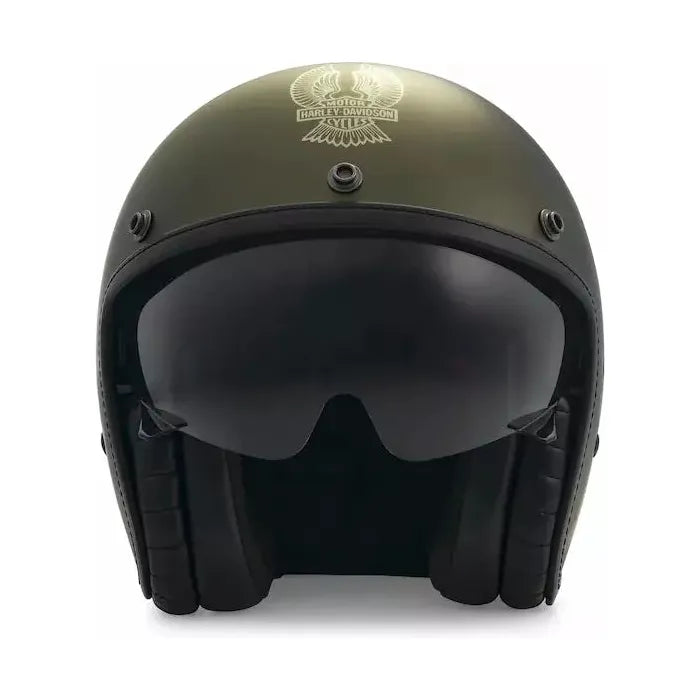
Titolo: CASCO HARLEY-DAVIDSON® SURPLUS X14 SUN SHIELD 3/4
Prezzo: £197.99
ACQUISTA ORA
- Visiera/Scudo:
Le visiere o gli scudi proteggono gli occhi del motociclista da vento, polvere e detriti. Alcuni caschi hanno visiere con rivestimenti antigraffio, antiappannamento o colorati per una maggiore protezione e visibilità.
- Imbottitura e fodera:
L'imbottitura e la fodera del casco svolgono un ruolo fondamentale per quanto riguarda comfort e vestibilità. Cerca caschi con materiali morbidi e comodi che assorbono il sudore e offrono una vestibilità aderente ma non costrittiva.
- Valutazioni di sicurezza:
Controllare le classificazioni di sicurezza del casco per assicurarsi che soddisfi gli standard di settore pertinenti, come gli standard DOT (Dipartimento dei trasporti) o ECE (Commissione economica per l'Europa).
III. Adattamento del casco

Titolo: CASCO BMW MOTORRAD GS CARBON EVO XCITE
Prezzo: £530.00
ACQUISTA ORA
A. Indossare il casco e regolare il cinturino sotto il mento:
Posiziona il casco sulla testa e allaccia saldamente il cinturino sottogola. Il cinturino deve essere aderente ma non troppo stretto, consentendo un po' di movimento alla mascella.
B. Assicurarsi che il casco aderisca perfettamente senza causare fastidio:
Il casco dovrebbe adattarsi perfettamente alla testa senza causare eccessiva pressione o fastidio. Se il casco risulta troppo largo o troppo stretto, provare una taglia o un modello diverso.
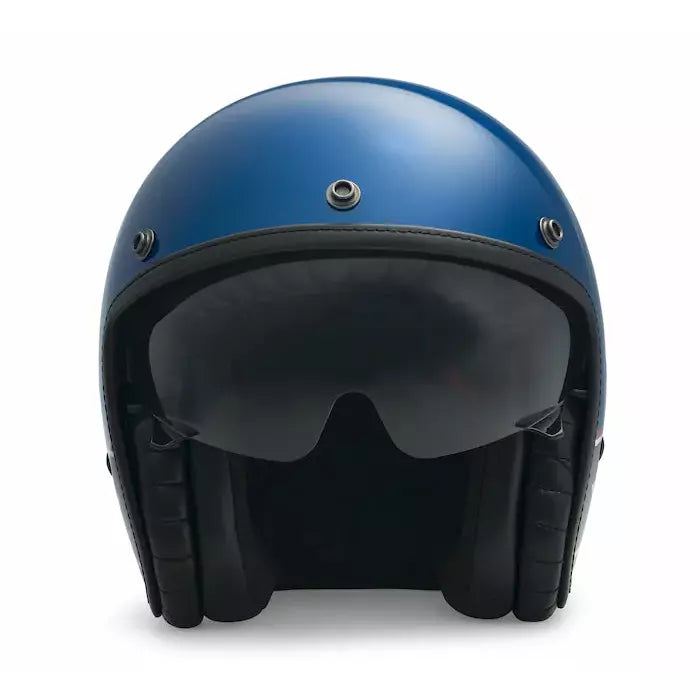
Titolo: CASCO HARLEY DAVIDSON® SUPERNOVA #1 X14 SUN SHIELD 3/4
Prezzo: £197.87
ACQUISTA ORA
C. Controllare il corretto posizionamento:
- Il casco deve essere posizionato in piano sulla testa, non inclinato indietro o in avanti:
Il casco dovrebbe essere posizionato in piano sulla testa, non inclinato indietro o in avanti. La parte superiore del casco dovrebbe essere circa un dito sopra le sopracciglia.
- * La fronte del casco dovrebbe essere circa un dito sopra le sopracciglia: *
La parte superiore del casco dovrebbe essere circa un dito sopra le sopracciglia. Questo assicura una visione corretta e riduce al minimo lo sforzo sul collo.
D. Valutare il movimento del casco:
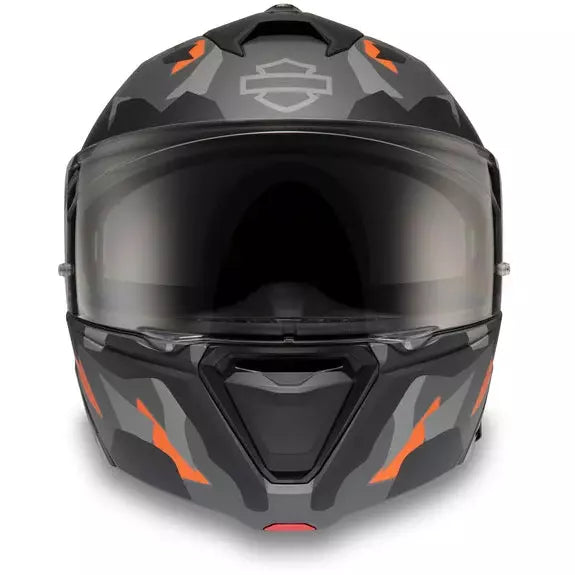
Titolo: CASCO MODULARE HARLEY DAVIDSON® CAPSTONE CAMO SUN SHIELD II H31
Prezzo: £247.33
ACQUISTA ORA
- Il casco non deve muoversi eccessivamente quando viene scosso da un lato all'altro o inclinato in avanti:
Scuoti il casco da un lato all'altro e inclinalo in avanti. Il casco non dovrebbe muoversi eccessivamente, il che indica una vestibilità sicura.
- Il casco non deve sollevarsi dalla testa quando il cinturino del mento è allacciato:
Quando il cinturino sottogola è fissato saldamente, il casco non dovrebbe sollevarsi dalla testa. Questo assicura che rimarrà in posizione in caso di incidente.
IV. Regolazione del casco
A. Stringere o allentare il cinturino del mento secondo necessità:
Regolare il cinturino sottogola per ottenere una vestibilità aderente e comoda. Il cinturino deve essere abbastanza stretto da tenere il casco saldamente in posizione, ma non così stretto da causare fastidio o limitare la respirazione.
B. Regolare il sistema di adattamento (se disponibile):
- Stringere o allentare il quadrante o la manopola sul retro del casco:
Alcuni caschi hanno un sistema di regolazione che consente di regolare la tenuta del casco. Stringere o allentare la manopola o il quadrante sul retro del casco a seconda delle necessità per una tenuta sicura e confortevole.
[Immagine di un motociclista che regola il sistema di regolazione del casco]
- Gonfiare o sgonfiare le sacche d'aria, se applicabile:
Alcuni caschi sono dotati di sacche d'aria che possono essere gonfiate o sgonfiate per personalizzare la vestibilità. Seguire le istruzioni del produttore per gonfiare o sgonfiare le sacche d'aria per ottenere una vestibilità aderente.
C. Rivedere la vestibilità e il posizionamento del casco:
Dopo aver regolato il sistema di adattamento, rivalutare la vestibilità e il posizionamento del casco per assicurarsi che aderisca correttamente alla testa e non provochi fastidio.
V. Garantire il comfort
A. Iniziare a rodare il casco indossandolo per brevi periodi:
Inizialmente, indossa il casco per brevi periodi per consentirgli di adattarsi alla forma della tua testa. Aumenta gradualmente la durata di utilizzo man mano che il casco si adatta.
B. Aggiungere o rimuovere imbottiture o fodere per una vestibilità personalizzata:
Se il casco risulta troppo largo o troppo stretto in alcune aree, si consiglia di aggiungere o rimuovere imbottiture o rivestimenti per ottenere una vestibilità personalizzata. Molti produttori di caschi offrono diversi spessori di imbottitura o rivestimenti per adattarsi a diverse forme della testa.
C. Considerare un sistema di comunicazione tramite casco per un maggiore comfort e praticità:
I sistemi di comunicazione tramite casco consentono ai motociclisti di comunicare tra loro, ascoltare musica o ricevere indicazioni GPS durante la guida. Questi sistemi possono migliorare il comfort e la praticità durante i lunghi tragitti.
VI. Conclusion
Scegliere il casco giusto e garantire una calzata adeguata sono essenziali per la sicurezza e l'esperienza di guida dei motociclisti. Un casco ben aderente offre una protezione ottimale, riduce il rumore del vento, minimizza l'affaticamento e aumenta il comfort. La regolare manutenzione e sostituzione del casco, se necessario, sono fondamentali per garantire sicurezza e comfort continui. Ricorda, il casco più costoso è inutile se non calza correttamente.
Link in uscita:
- Sicurezza del casco da motociclista della National Highway Traffic Safety Administration (NHTSA)
- Leggi e regolamenti sui caschi da motociclista dell'American Motorcycle Association (AMA)
Sommario
Schema
- Introduzione
- Scegliere il casco giusto
- Adattamento del casco
- Regolazione del casco
- Garantire il comfort
- Conclusione
Domande frequenti (FAQ)
- D: Perché è importante scegliere il casco giusto?
- D: Come faccio a determinare la forma e le dimensioni della mia testa?
- D: Quali sono i diversi tipi di casco?
- D: Quali caratteristiche dovrei considerare quando scelgo un casco?
- D: Come si adatta correttamente il casco?
- D: Come si regola la calzata di un casco?
- D: Cosa posso fare per garantire il massimo comfort quando indosso un casco?
- D: Con quale frequenza dovrei sostituire il casco?
R: Scegliere il casco giusto è fondamentale per la tua sicurezza e il comfort di guida. Un casco della misura giusta offre una protezione ottimale, riduce il rumore del vento, minimizza l'affaticamento e aumenta il comfort durante le corse.
R: Per determinare la forma e le dimensioni della testa, misura la circonferenza della testa utilizzando un metro a nastro flessibile. Posiziona il metro attorno alla fronte, leggermente sopra le sopracciglia, e avvolgilo attorno alla parte più larga della testa. Registra la misurazione in pollici o centimetri. Puoi anche consultare una tabella delle taglie dei caschi per trovare la taglia giusta per la forma della tua testa.
R: I principali stili di casco includono caschi integrali, caschi aperti e caschi modulari. I caschi integrali offrono la massima protezione, mentre i caschi aperti offrono una copertura minore. I caschi modulari combinano i vantaggi dei caschi integrali e aperti.
R: Considera caratteristiche come ventilazione, visiera/scudo, imbottitura e fodera e classificazioni di sicurezza quando scegli un casco. La ventilazione assicura comfort durante il caldo o i lunghi viaggi, mentre una visiera o uno scudo proteggono gli occhi da vento, polvere e detriti. Imbottiture e fodera comode sono essenziali per una vestibilità aderente. Controlla le classificazioni di sicurezza per assicurarti che il casco soddisfi gli standard del settore.
R: Per adattare correttamente un casco, indossalo, regola il cinturino sottogola e assicurati che il casco aderisca perfettamente senza causare fastidio. La fronte del casco dovrebbe essere circa un dito sopra le sopracciglia. Il casco non dovrebbe muoversi eccessivamente quando viene scosso o inclinato in avanti. Quando è allacciato, il cinturino sottogola dovrebbe mantenere il casco saldamente in posizione.
R: Se necessario, puoi regolare la vestibilità del tuo casco stringendo o allentando il cinturino sottogola. Alcuni caschi hanno un sistema di vestibilità che ti consente di regolare la tenuta nella parte posteriore del casco. Se applicabile, puoi anche gonfiare o sgonfiare le sacche d'aria per personalizzare la vestibilità.
R: Ammorbidisci il tuo casco indossandolo inizialmente per brevi periodi. Puoi anche aggiungere o rimuovere imbottiture o rivestimenti per una vestibilità personalizzata. Considera un sistema di comunicazione per casco per un maggiore comfort e praticità durante i lunghi viaggi.
R: La durata di vita consigliata di un casco è in genere di 3-5 anni, a seconda dell'uso e della manutenzione. È importante ispezionare regolarmente il casco per eventuali danni e sostituirlo se necessario.
Scopri di più:
Scopri l'equipaggiamento KTM definitivo e libera l'avventuriero che è in te Esplora la collezione KTM
-
Ravviva il tuo stile con le nostre splendide giacche da motociclista Esplora la collezione di giacche da moto
Preparati per sicurezza e stile con caschi da moto di alta qualità Esplora la collezione di caschi da moto
Abbraccia la raffinatezza italiana con la nostra collezione Ducati Esplora la collezione Ducati
Migliora la tua guida con l'abbigliamento BMW senza pari Esplora la collezione BMW
Senti il brivido della Kawasaki: esplora la nostra collezione dinamica Esplora la collezione Kawasaki
Dalla testa ai piedi: acquista la nostra gamma completa di abbigliamento per motociclisti Esplora la collezione di abbigliamento per motociclisti